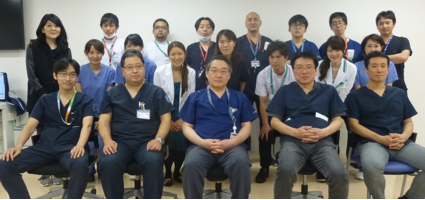
- About Us
- Medical School
- Graduate School
- Research
- Research TOP
- Research Departments
- Research Topics
- Research Facilities
- Intellectual Property Promotion Center(TLO)
- Affiliated Hospitals
Department of Cardiovascular Surgery
The Department of Cardiovascular Surgery at Nippon Medical School is one of the oldest departments that have performed cardiac surgery from the dawn era of this challenging territory in Japan. The first direct cardiac procedure was performed in 1964 followed by the first open heart surgery using a cardio-pulmonary bypass in 1965. Since then, various cardiac and vascular surgeries have been performed on approximately 10 thousands of patients.
One of the characteristic features of our hospital is the nation’s foremost advanced critical care centers (CCU, SCU, and CCM) that receive many emergency and critical patients with cardiovascular diseases, stroke, and trauma, respectively. Accordingly, the number of acute coronary patients received by our CCU is the highest among the institutes in the Tokyo metropolitan area. Moreover, our center is conducting interventional or surgical cardiovascular procedures, such as coronary bypass surgery and aortic surgery, on a 24-hour basis.
Some notable features of our Department of Cardiovascular Surgery are as follows: Firstly, we perform coronary bypass surgeries on many patients referred from the CCU at any time as described above and the most of the patients undergo beating heart surgeries without using a cardiopulmonary bypass (OPCAB). Secondly, our surgical treatment for cardiac arrhythmias such as atrial fibrillation (AF) or ventricular tachycardia (VT) associated with or without other cardiac diseases provides the best quality and the highest cure rate of these intractable arrhythmias in the country. Thirdly, aortic patients, such as aortic dissection, aneurysm, or others, are treated by the vascular team consisted of vascular surgeons, interventional radiologists, and cardiologists in order to perform effective and minimally invasive treatments as possible. Finally, we conduct surgical treatment of coronary artery aneurysm associated with juvenile Kawasaki disease.
It was back in 1989 when the first surgical procedure for AF, the LA Isolation, was performed in Japan in our institute, followed by the first modified Maze procedure in mitral valve patient in October 1991. Until now, approximately 550 cases have undergone AF surgery in our institute. We perform an optimal procedure on each patient based on the LA size or other parameters in order to restore a more atrial transport function. Intraoperative mapping using a 512-channel three-dimensional mapping system has provided us a direct information of the atrial activation during AF to determine the optimal lesion set in each patient. More recently, active ganglionated plexi were mapped and ablated combined with the Maze procedure to pursue complete elimination of AF.
Surgery for VT is another characteristic therapy in our department. Patients with VT refractory to or inadequate for endocardial or epicardial catheter ablation have been referred from various cardiac centers all around Japan for definitive surgical procedure to eradicate VT. Some patients had been in VT storm with frequent defibrillator shocks, necessitating an urgent surgery. Intraoperative electro-anatomical mapping supported by EP specialists in the Department of Cardiovascular Medicine allowed us to perform accurate surgical cryoablation, resulting in excellent outcome even in those critical patients.
We hope to continue the over 50 years of tradition in Cardiovascular Surgery at the Nippon Medical School by actively engaging in the treatment of patients with advanced diseases.


